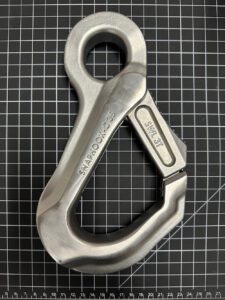
The latest supplies and equipment geared toward commercial fishermen have been stronger, smarter and more resilient to address the unique challenges those in the industry face. Although that’s how gear in the industry has naturally progressed, recent developments have utilized innovative solutions in order to address several issues.
Some of the newest products and trends: creative collaborations for advanced hooks, smart technology in buoys, predator and abrasion resistant netting and an increase in demand for cod coil collapsible slinky pots.
Fishermen’s News reached out to several manufacturers and suppliers to find out the latest products on the market, what the big sellers are and recent trends.
LFS INC.
There’s been a tendency to move away from having knots, Seine Division Manager Josiah Campbell noted in an email to Fishermen’s News. As well as the need for smaller diameter twines that are still ultra-abrasion resistant, commercial fishing crews also need “stronger, faster, tougher” gear.
In response to these trends, LFS has made some noteworthy partnerships recently to take commercial fishing gear to the next level.
LFS recently introduced a new hook to their catalog as the result of partnering with Asano Metal Industry, a worldwide stainless-steel product manufacturer based in Japan.
The safety hook is a common item on commercial fishing vessels, Campbell pointed out. Tenders, crabbers and seiners all use this product, despite its well-known shortcomings, he said.
“The opening mechanism can be difficult to operate in gloves. This mechanism will seize due to corrosion if not maintained,” he explained. “We wanted to bring to the industry a hook that is more ergonomic and doesn’t require constant maintenance.”
The snap hook type-C, or crab hook (in Asano’s product portfolio), is LFS’s new product to solve some of these issues.
“The hook is not self-closing like a safety hook, but is easy to operate gloved,” Campbell said. “The closing mechanism is simple and corrosion resistant. The ability to operate one handed is a huge benefit.”
It also has a safe waring load of three tons. Asano is notoriously conservative with their safe waring load claims, Campbell said.
“Break strength of the crab hook is over 20 tons,” he added.
The unique collaboration with Asano started after Campbell was introduced to Asano in 2015 when he worked for the Homer, Alaska-based manufacturer Bulletproof Nets. LFS bought Bulletproof Nets in early 2020. While the brand will remain, it is now a fully integrated division of LFS.
Asano was willing to develop products specifically for commercial fishing, Campbell recalled, and the partnership began.
“We have continued to develop new products for our fleet where there are obvious needs,” Campbell said. “The design process can take years—that being said, I have always valued Asano’s willingness to modify (and) evolve products, and to constantly improve performance.”
LFS has also recently teamed up with Fisa, a Peru-based high-quality net manufacturer, for an upgraded polyethylene (PE) netting.
“With our new collaborative effort…we worked with them to create the best polyethylene chafe gear on the market for purse seine,” Campbell said.
High quality polyethylene is the start, then the core fiber to jacket ratios are balanced for the different diameters, he explained.
“Knot stability is very important for the larger diameter and bar strength on the smaller diameters,” he said. “The small diameter Supra has made a significant difference for vessels (that) need to fish shallow water, or…need an abrasion resistance top strip.”
“Stronghold was built with LFS research to be the best PE web for the seine fisheries,” Campbell added.
More information is available at lfsinc.com/commericalfishinggear
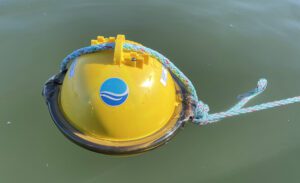
BLUE OCEAN GEAR
The next generation of buoys for commercial fishing are already here and they’re utilizing smart technology, with real- time tracking and monitoring for deployed fishing gear. That means spending less time searching and more time hauling.
Blue Ocean Gear Inc. recently developed intelligent, connected buoys that monitor the location and movement of any type of deployed gear along with local conditions—anytime, anywhere.
“We’ve spent years developing this technology in partnership with fishers, as they truly know what will work with their gear and the conditions out on the open ocean,” Blue Ocean Gear CEO Kortney Opshaug told Fishermen’s News. “We continue to add features driven by fishermen as well to make the technology easier and more useful for their operations.”
Opshaug explained that going out on the water and seeing how often gear moved or was underwater and not able to be hauled was an eye-opener regarding how much fuel is wasted in the industry by not having any tracking mechanism on surface gear.
“When fishermen put thousands of dollars of gear on the water, they’re trusting that it’s in the same location when they come back to harvest,” she remarked. “By developing the smart buoys, we were able to effectively give fishermen eyes on the water to know where their gear is at all times, and to know if unusual movement was happening.”
Gear moves around a lot in Alaskan waters due to strong tides and currents. It also can get dragged underwater for days at a time.
“In these conditions, fishers can spend hours searching for their end lines, wasting fuel—and we’re at a time when fuel costs are skyrocketing,” Opshaug said. “These vessels use the smart buoys to know which strings are up on the surface and pinpoint where they are on their chart plotter to be able to go directly to their gear without searching.”
Fishers using deep-set buoys for swordfish are also using the smart buoys to be able to detect when a strike happens or to prevent gear loss. Black cod longliners use the smart buoys to track their end lines so they know if the line has parted or to share their gear location with other vessels in the area and avoid gear conflict.
“Saving money is the key, whether it’s in the form of time spent on the water, which translates into fuel costs, or by preventing gear loss that would otherwise costs thousands of dollars to replace,” Opshaug noted.
The company also has a project in the works—with NOAA sponsorship—to use anonymized temperature data transmitted by smart buoys on fishing gear in the Bering Sea. The information collected will be shared with the National Weather Service’s Ice Desk.
“The goal will be to have data from fishing gear be used to help with sea ice behavior forecasting, something that is very difficult to predict and which is critical for vessels operating near the ice pack,” Opshaug explained.
“Having data from the areas where it is most relevant should be useful in these situations where there may not be enough spatial resolution to the data otherwise available, with safety and operational benefits to the vessels that use those predictions in their fishing,” she added.
In the first quarter of 2022, the company introduced integration of the Smart Buoys with Time Zero chart plotters, which allowed fishermen to see all of their gear relative to the boat on their display.
This means they don’t need another app or device. They just operate the way they’re used to fishing but with more information in front of them.
Last summer, Blue Ocean introduced an upgraded buoy housing with a more rugged design to withstand the high-force conditions seen far offshore, but also with rough handling on deck. The ability to change the timing for data transmission remotely is also an improvement that lets the company tune the buoys for each particular fishery.
Blue Ocean Gear plans to launch its vessel transceiver in early 2023, which will include radio transmission between the buoys and the vessel, eliminating any need for internet connectivity to display gear locations.
For more information, visit blueoceangear.com.
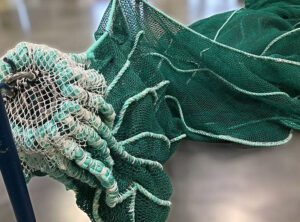
WIRECO
Working on netting for commercial fishing and aquaculture, WireCo, a leader in the production of steel and synthetic ropes and netting, has recently developed new netting to defend against some of the industry’s harshest foes.
Looking ahead, growth trends in aquaculture and commercial fishing appear to extend well into the future, WireCo President of Global Synthetics José Gramaxo told Fishermen’s News. This is particularly the case in the developing world and portions of Asia, he added.
“And, as the scale of such operations grows, so, too, will the need for more robust solutions,” Gramaxo said.
Fish farming, for example, will increasingly move to deeper waters, subjecting ropes and netting to interactions with more capable predators and stronger ocean currents, he said.
“We can’t stop innovating,” WireCo Global Director of Fishing Miguel Sa added. “Neither our customers nor the ocean will allow us to fall behind.”
Abrasive forces acting upon trawling nets are often significant enough to curtail the nets’ useful service lives, Gramaxo explained.
“This leads to increased costs, as fishermen are forced to change out worn nets more frequently,” he said.
As a solution, Euronete, one of WireCo’s primary brands, introduced EuroLine Tipto in July. It was developed in Portugal, where WireCo’s commercial fishing operation is based.
“It is a next-generation cod-end netting that builds upon EuroLine’s market-leading strength, drag resistance and ease of handling and repair,” Gramaxo explained.
The new net combines these qualities and adds extra abrasion resistance, yielding a net that offers greater longevity and reduced operating costs for fishermen.
“It surpasses anything we’ve done in trawling thus far,” Sa said.
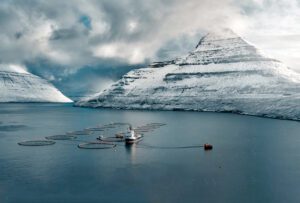
Harbor seals, sea lions, and other marine predators chew through nets, jump over and into enclosures and find other ingenious means to gain access to captured or caged fish, Gramaxo explained.
“Not only does this impact yields, but it also endangers the lives of the predators,” he said. “For those animals able to defeat fishermen’s defense mechanisms, but unable to free themselves once inside an enclosure, the feast they enjoy proves to be their last. Nobody wants that.”
That can be highly problematic for those serving the commercial fishing and aquaculture industries, he noted.
“It’s been a challenge from the very beginning,” Sa added. “Our team is continually focused on driving innovation and sustainable solutions to address issues that have been plaguing the industry for years.”
WireCo recently developed EuroStone as one of those innovative solutions. The cut-resistant predator net was introduced by WireCo’s Euronete brand in summer 2021.
“The net has proven highly effective at keeping ocean scavengers out of aquaculture cages,” Gramaxo stated.
EuroStone combines high-tenacity polyethylene and a stone fiber core. The nets are sinkable, recyclable, UV-resistant and unsusceptible to algae growth.
It also was developed at the company’s commercial fishing headquarters in Portugal. The new netting was tested in waters off Scotland and Chile. EuroStone 2.2 mm was first tested in Scotland in November 2020, while EuroStone 6.0 mm was first tested in Chile in April 2021.
“EuroStone has gained strong acceptance in the global marketplace, owing largely to fish farming’s growing importance as populations seek sustainable protein sources,” Gramaxo said.
The fish farming trend is expected to continue, he added, with aquaculture projected to reach $262 billion worldwide by 2026, according to the U.S. Department of Commerce’s International Trade Administration.
For more information, visit wireco.com/innovative-solutions/fishing and euronete.com.
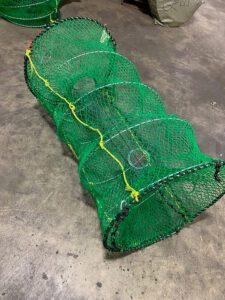
ENGLUND MARINE
West Coast suppliers of commercial fishing gear have noted that CodCoil collapsible slinky pots have gained some traction recently. They allow smaller vessels to be able to take advantage of fisheries traditionally done by larger vessels.
Englund Marine and Industrial Supply, an Astoria, Ore.-based company with multiple locations on the West Coast, has served the marine and industrial community for 75 years. Greg Matthews, from Englund, commented on the trend in an interview with Fishermen’s News.
“They’ve seen an uptick in demand for the cod coil slinky pots primarily for the West Coast black cod (sable fish) fishery,” Matthews stated in an email.
“These pots work really well for smaller vessels that do not have the capacity to stack traditional-style black cod pots on deck,” he added. “The collapsible slinky pot allows smaller vessels to capitalize on the fishery where they could not in the past.”
The benefits, he added “are that they are very cost efficient, they do not take up a lot of deck space, they’ve proven to be productive and there is little to no bycatch.”
For more information, visit englundmarine.com/pages/commercial.html.
Sara Hall has 15 years of experience at several regional and national magazines, online news outlets, and daily and weekly newspapers, where coverage has included reporting on local harbor activities, marine-based news, and regional and state coastal agencies. Her work has included photography, writing, design and layout.
